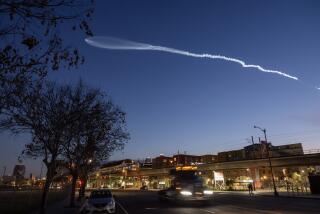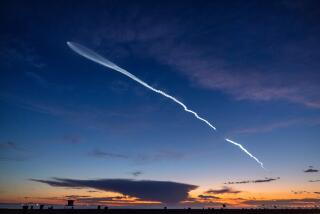Air Force launches unarmed nuclear missile from Vandenberg overnight, lands near Marshall Islands

- Share via
The Air Force launched an unarmed missile from Vandenberg Space Force Base overnight, in a demonstration of the readiness of the U.S. nuclear arsenal.
The Minuteman III intercontinental ballistic missile was launched from the Santa Barbara County base around 1 a.m. Wednesday. The goal is to “demonstrate the readiness of U.S. nuclear forces and provide confidence in the lethality and effectiveness of the nation’s nuclear deterrent,” according to the Air Force Global Strike Command. The country has performed more than 300 similar tests in the past.

The missile was shot over the Pacific Ocean and traveled more than 4,200 miles to a test range in the Marshall Islands.
The Minuteman is a powerful weapon, capable of carrying three nuclear warheads that can reach independent targets more than 6,000 miles away, according to the Air Force. Its range from the Vandenberg base could span as far north as the North Pole, as far south as the closest point of Antarctica, as far west as the Philippines and as far east as Spain.
At its peak speed, the Minuteman can travel 15,000 mph — about 25 times as fast as a typical passenger jet and almost 70 times faster than the fastest Ferrari. It’s nearly 60 feet long and weighs about 80,000 pounds.
Video released by Vandenberg Space Force Base showed the launch of the missile and its travel across the sky.
America’s ballistic missiles can reach targets around the globe about 30 minutes after launch. During the first three minutes, three solid fuel rocket motors power the missile’s flight. Then, the missile follows a curve-shaped trajectory, releasing the warhead midcourse and sending it toward the target.
Wednesday morning’s routine test of the missile was scheduled years in advance and will be used to verify the effectiveness, readiness and accuracy of the weapons system, according to the Air Force. Per its international agreements, the United States notified Russia and the more than 140 nations that are members of the Hague Code of Conduct Against Ballistic Missile Proliferation of the planned launch. The launch was “not a response to current global events,” the Air Force said.
“We collected and analyzed performance and other key data points to evaluate current missile system competencies,” said Col. Dustin Harmon, 377th Test and Evaluation Group commander. “This allows our team to analyze and report accuracy and reliability for the current system while validating projected missile system improvements. The data we collect and analyze is crucial for maintaining Minuteman III while we pave the way for Sentinel.”
The last routine test took place Nov. 5 when a Minuteman III was launched from the Vandenberg base and traveled more than 4,000 miles to the Marshall Islands. It landed at the U.S. Army Space and Missile Defense Command’s Ronald Reagan Ballistic Missile Defense Test Site, where researchers used flight data to evaluate system performance.
“These tests are demonstrative of what Striker Airmen bring to the fight if called by the president,” said Gen. Thomas A. Bussiere, commander of the Air Force Global Strike Command, in a statement on the November launch. “An airborne launch validates the survivability of our ICBMs [intercontinental ballistic missiles], which serve as the strategic backstop of our nation’s defense and defense of allies and partners.”
The Air Force has 400 Minuteman III missiles in service at bases in Wyoming, Montana and North Dakota. These missiles have been a mainstay of America’s nuclear arms force since the 1970s, and most of the system’s fundamental infrastructure still uses the original equipment.
Starting in 2029, the Air Force intends to begin gradually replacing the Minuteman III with a modernized arsenal of LG-35A Sentinel missiles. Until full capability of the Sentinel missiles is achieved in the mid-2030s, the Air Force says it is committed to ensuring Minuteman III remains a viable deterrent.
The United States has the second-largest number of nuclear weapons in the world with about 5,040 warheads, according to data collected by the Federation of American Scientists. Russia has the largest stockpile with about 5,580 warheads.
The two superpowers are followed by China with about 500 warheads, France with 290 and the United Kingdom with 225.
More to Read
Sign up for Essential California
The most important California stories and recommendations in your inbox every morning.
You may occasionally receive promotional content from the Los Angeles Times.












